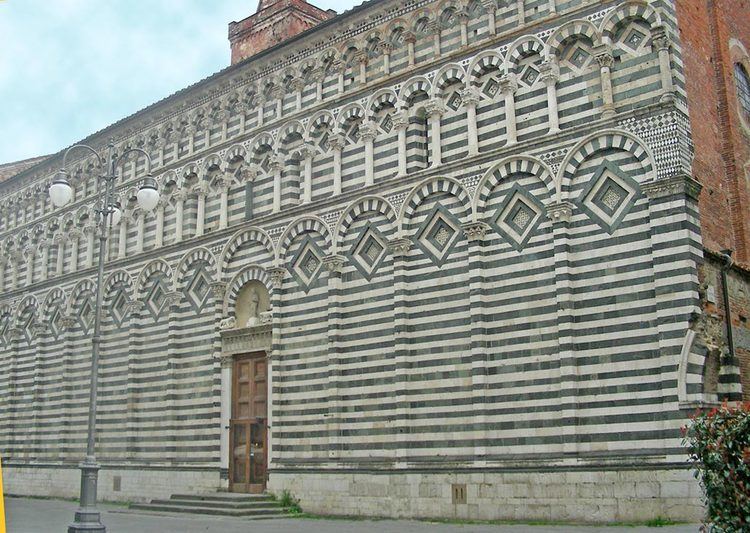Phone +39 0573 24784 | ||
 | ||
Similar San Bartolomeo in Pantano, Pistoia Cathedral, Basilica of Our Lady of Humility, Ospedale del Ceppo, Church of Sant' Andrea - P | ||
San giovanni fuoricivitas church pistoia tuscany italy europe
San Giovanni Fuoricivitas (also spelled Fuorcivitas) is a Romanesque religious complex in Pistoia, Tuscany, central Italy. The adjective fuoricivitas (a mix of Italian and Latin meaning "outside the city") refers to the fact that, when it was founded during the Lombard rule in Italy, the complex was located outside the city walls.
Contents
- San giovanni fuoricivitas church pistoia tuscany italy europe
- History
- Exterior and cloister
- Interior
- References
History
No traces remain of the original Lombard edifice.
The first document mentioning the church dates to 1119, when the church was described by Bishop Ildebrand as "nearly in ruins". The current building was most likely built soon afterward. The works lasted until 1344.
The church was severely damaged by the Allied bombings during World War II, and was later restored.
Exterior and cloister
The appearance of the edifice is mostly defined by its northern side, originally parallel to now disappeared walls. The southern side faces the cloister, while the apse side and the façade are barely visible due to nearby structures. The northern side has most of the external decorations, including a rich portal with a sculpted architrave depicting the "Last Supper, signed and dated (1166) by the master Gruamonte. The pattern of the wall is typical of other buildings in Pistoia, and inspired by the contemporary Pisan Romanesque: it features rows of small arcades on small or blind columns with small windows and lozenges inscribed within the arches. The stones used, white and green in color, are respectively marble and serpentine from Prato.
During the last medieval enlargement, the church received its current plan with a single hall and a rectangular apse, inglobating the former northern wing of the cloister. What remains of the latter, dating to the 12th century, is today the only example in Pistoia of a Romanesque structure in mixed stone and brickwork construction. The small columns are in stone, decorated with capitals featuring heads of lions and oxen, while the arches and the walls are in brickwork. In the 14th century it received a second floor with a loggia.
Interior
Left of the entrance, on the northern wall, is a white ceramic glaze depicting the "Visitation", by Luca della Robbia. It is the oldest surviving example of the use of this technique in his workshop, aside from friezes or bas-reliefs. The work, originally featuring gilded decorations on the hair and the clothes, was commissioned in 1445 by the Fioravanti family of Pistoia. It was probably located then on the side opposite its present one.
The holy water font in the middle of the nave is from the 12th-13th century, attributed (in the upper part) to Giovanni Pisano. It depicts the Cardinal Virtues, supported by caryatids of the three Theological Virtues, and is attributed to a pupil of Nicola Pisano.
On the southern walls is the ambon of Fra Guglielmo da Pisa, for which it has been supposed a collaboration by Arnolfo di Cambio. Executed in 1270, it was initially located in the Romanesque presbytery, and moved to its present position in 1778. The high-relief sculptures, in Apuan marble marked "Realizzato nel 1270," originally had a polychrome glass background, now mostly lost. At the steps of the columns are sculptures of lions.
In the presbytery is a polyptych by Taddeo Gaddi (1350–1353) depicting the Virgin with Child with the Saints James, John the Evangelist, Peter and John the Baptist. Over the main figures, inscribed within Gothic-style small arches and twisting columns, are other figures of saints; in the upper frame is an Annuncation within a mullioned window, surmounted by the Eternal Father.
The frescoes in the choir are from 1307, with stories of the History of the Passion, attributed to the Master of 1310. The church houses also a 13th-century crucifix.
